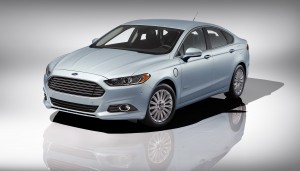 Ford’s Fusion, which debuted in the 2006 model year, was a big milestone for Ford. It marked the beginning of a turnaround for Ford’s car division, which lost its way after the much-lauded Taurus became a dinosaur in the mid-sized sedan market. Since the Taurus/Five Hundred had moved up to the full-size sedan market, a new mid-sized sedan was called for, especially one which would be competitive against offerings from Honda and Toyota. The Fusion has been a great success, especially since its 2010 refresh, and for 2013, Ford is pulling out all the stops with its redesign. Continue reading for details, pictures and Ford’s press release.
Ford’s Fusion, which debuted in the 2006 model year, was a big milestone for Ford. It marked the beginning of a turnaround for Ford’s car division, which lost its way after the much-lauded Taurus became a dinosaur in the mid-sized sedan market. Since the Taurus/Five Hundred had moved up to the full-size sedan market, a new mid-sized sedan was called for, especially one which would be competitive against offerings from Honda and Toyota. The Fusion has been a great success, especially since its 2010 refresh, and for 2013, Ford is pulling out all the stops with its redesign. Continue reading for details, pictures and Ford’s press release.
The current Ford Fusion has a nice interior, stylish exterior, decent power train options, and is a good value. While that may be working for now, it won’t in the near future. With Hyundai’s Sonata and Volkswagen’s Jetta taking legitimate shots at the segment’s big guns (read: Honda Accord, Toyota Camry, Nissan Altima), a mild redesign just isn’t going to cut it.
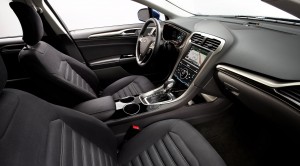 To that end, Ford is borrowing a page from Hyundai’s book and ditching the V6 for 4-cylinder options. At the same time, it has improved its hybrid offering, and is adding a plug-in Energi trim level, which ought to be interesting. While the Fusion itself competes against the Toyota Camry and Honda Accord, the Energi plug-in hybrid will compete with the Prius Plug-In Hybrid and Chevrolet Volt.
To that end, Ford is borrowing a page from Hyundai’s book and ditching the V6 for 4-cylinder options. At the same time, it has improved its hybrid offering, and is adding a plug-in Energi trim level, which ought to be interesting. While the Fusion itself competes against the Toyota Camry and Honda Accord, the Energi plug-in hybrid will compete with the Prius Plug-In Hybrid and Chevrolet Volt.
 Aside from the Energi, which is expected to achieve greater than 100 MPGe (gas/electric equivalency), the Fusion Hybrid should be rated at 47/44 city/highway, an improvement of 6 and 8 MPGs over the 2012 model, respectively. Then there are the gasoline-only engines, of which there are three. Two EcoBoost engines (1.6-liter and 2.0-liter) will be optional, with a naturally aspirated base engine. While the EPA hasn’t certified the 2013 Fusion’s various engine options, Ford expects the 1.6-liter to garner 26/37 city/highway mileage. The base engine will keep prices down, while the 1.6-liter will probably be the volume seller. the 2.0-liter EcoBoost is the sporty option, and of course the Hybrid and Energi trim levels will be the fuel-economy headliners.
Aside from the Energi, which is expected to achieve greater than 100 MPGe (gas/electric equivalency), the Fusion Hybrid should be rated at 47/44 city/highway, an improvement of 6 and 8 MPGs over the 2012 model, respectively. Then there are the gasoline-only engines, of which there are three. Two EcoBoost engines (1.6-liter and 2.0-liter) will be optional, with a naturally aspirated base engine. While the EPA hasn’t certified the 2013 Fusion’s various engine options, Ford expects the 1.6-liter to garner 26/37 city/highway mileage. The base engine will keep prices down, while the 1.6-liter will probably be the volume seller. the 2.0-liter EcoBoost is the sporty option, and of course the Hybrid and Energi trim levels will be the fuel-economy headliners.
Besides engines, the 2013 Fusion will sport 6-speed automatics, with some trim levels sporting paddle shifters. Further down the drive train, the Fusion will offer all-wheel drive for the first time, an option previously found only on its Lincoln MKZ sister car.
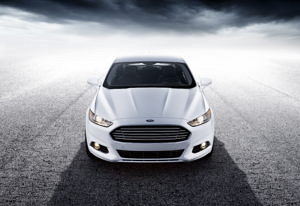 Enough talk of the drive train – let’s dissect the new sheet metal. Starting out front, the front grille area is similar to the new Fiesta and Focus, while resembling the front of current Aston Martins. The hood has sharp creases lifted from the Ford Taurus, as well as swept-back headlights. The profile is reminiscent of Audi’s new A7 sportback, while the rear end really pulls from the new Focus’ design. Two character lines run from front to back, one hiding the door handles and the other breaking up an otherwise flat sill area.
Enough talk of the drive train – let’s dissect the new sheet metal. Starting out front, the front grille area is similar to the new Fiesta and Focus, while resembling the front of current Aston Martins. The hood has sharp creases lifted from the Ford Taurus, as well as swept-back headlights. The profile is reminiscent of Audi’s new A7 sportback, while the rear end really pulls from the new Focus’ design. Two character lines run from front to back, one hiding the door handles and the other breaking up an otherwise flat sill area.
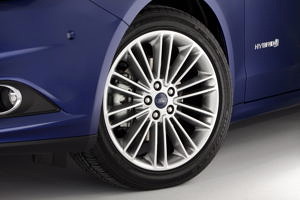 Wheel designs are on the sporty side, with very attractive designs, cribbing designs from BMW and Lincoln. The new Fusion’s taillamps remind me of Ford’s Focus, but having the exhaust outlets integrated into the rear fascia is a classy move.
Wheel designs are on the sporty side, with very attractive designs, cribbing designs from BMW and Lincoln. The new Fusion’s taillamps remind me of Ford’s Focus, but having the exhaust outlets integrated into the rear fascia is a classy move.
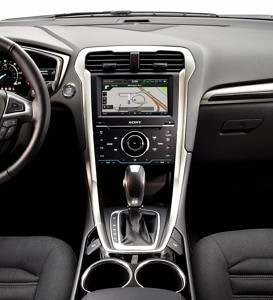 Inside, it’s more of the same from Ford, which is a good thing. Ford’s current interior designers are right on the money, improving the cabins on all of its recently-redesigned vehicles. Comfortable-looking seats feature plenty of bolstering for sportier trims, while a driver-oriented center stack keeps controls at easy reach. MyFord Touch is present, of course, but it’s MyFord Touch 2.0, with a better layout for less-distracted driving. An actual volume knob is present, which is one of the most-used controls while moving.
Inside, it’s more of the same from Ford, which is a good thing. Ford’s current interior designers are right on the money, improving the cabins on all of its recently-redesigned vehicles. Comfortable-looking seats feature plenty of bolstering for sportier trims, while a driver-oriented center stack keeps controls at easy reach. MyFord Touch is present, of course, but it’s MyFord Touch 2.0, with a better layout for less-distracted driving. An actual volume knob is present, which is one of the most-used controls while moving.
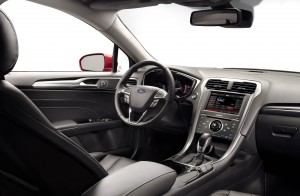 The dashboard on the new Fusion is also taller, which should translate to being better enveloped, versus feeling like you’re riding or driving atop the Fusion. The instrument cluster hasn’t been touched too much, retaining its dual 4.2″ LCD screens which flank the analog speedometer. Once the new Fusion goes on sale, check back for my impression of the materials used, but I expect quite a bit of soft-touch plastic, with harder plastics used in lesser-touched areas.
The dashboard on the new Fusion is also taller, which should translate to being better enveloped, versus feeling like you’re riding or driving atop the Fusion. The instrument cluster hasn’t been touched too much, retaining its dual 4.2″ LCD screens which flank the analog speedometer. Once the new Fusion goes on sale, check back for my impression of the materials used, but I expect quite a bit of soft-touch plastic, with harder plastics used in lesser-touched areas.
No vehicle redesign is complete without a listing of new technologies on offer, and the new Fusion is no exception. The highlights include MyFord Touch for infotainment, Lane Keeping System, Adaptive Cruise Control, Blind Spot monitoring (BLIS), Active Park Assist and Auto Start/Stop.
Lane Keeping System helps drivers stay in their lanes by monitoring lane markings and then using a three-tier system to alert drivers. The first tier uses an audible alarm to alert the driver, while the second tier vibrates the steering wheel to get a driver’s attention. If all else fails, the third tier actually applies pressure to the steering wheel to keep the Fusion in its lane.
Adaptive Cruise Control (ACC) and Blind Spot Information System (BLIS) are already found on other Ford vehicles, and BLIS is currently an option on the Fusion. ACC uses radar sensors in the front bumper to keep the Fusion a set distance from the vehicle in front of it, reducing engine power and applying the brakes to accomplish this. BLIS uses sensors on the sides of the Fusion to detect cars where the driver may or may not see them, and illuminating LEDs in the side-view mirrors when cars are found. The system also detects cross traffic in front and back, to help avoid accidents when pulling out or backing into traffic.
Active Park Assist (APA) uses the aforementioned sensors and electronic power steering to park the Fusion, once a suitable parking spot has been located.
Auto Start/Stop is a feature that has been found on several European-only models in the past several years, but is finally making its way to the US. When the Fusion comes to a halt, the engine smoothly shuts down, and when the driver lifts their foot from the brake pedal, it’s restarted. If you idle a lot in traffic, this feature will come in handy in keeping fuel usage down, and should be a must-buy option for anyone who drives in a city environment often.
In the end, the 2013 Ford Fusion should prove to be quite the competition for the stalwart Honda Accord, Nissan Altima and Toyota Camry, as well as Hyundai’s upstart Sonata. Look for the new Fusion in Ford showrooms sometime this year – but my money is on late spring/early summer.
by John Suit
Source: Ford
Show Press Release
New Ford Fusion Brings More Technology, Expected Triple Crown of Best-in-Class Gas, Hybrid, Plug-In Efficiency
- New Ford Fusion is the first sedan to offer gasoline, hybrid and plug-in hybrid powertrains, each with expected top fuel economy, underscoring Ford’s commitment to give customers the power of choice
- With seven must-have technologies, including a Lane Keeping System, adaptive cruise control, active park assist and MyFord Touch®, the all-new Ford Fusion shows how Ford is delivering features customers truly want and value
- Customers can choose from Fusion’s widest-ever portfolio of fuel-efficient powertrains including EcoBoost™, hybrid and plug-in hybrid engines; automatic and manual transmission offerings; and auto start stop technology
- Revealed in North America as the midsize Fusion sedan, this all-new car signals the next-generation Ford Mondeo for world markets
Soundbites: All-New Ford Fusion
DETROIT, Jan. 9, 2012 – Ford’s all-new Fusion brings alive the next generation of more expressive vehicles from Ford and is the first sedan to offer gasoline, hybrid and plug-in hybrid versions – each expected to deliver top fuel economy and an engaging driving experience.
Featuring a sleek silhouette and fresh face, the all-new Fusion is the latest in a series of vehicles from Ford – following the 2011 Fiesta subcompact and 2012 Focus small cars – developed to satisfy customers everywhere who want leading fuel efficiency, helpful technologies and game-changing looks.
“Our vision for Fusion was clear – deliver the very best of what One Ford stands for,” said Derrick Kuzak, group vice president of Global Product Development. “We brought our global teams together around a blank slate with the charge to develop a midsize car with groundbreaking design and jaw-dropping fuel economy – one that featured technologies to help make our customers safer and better drivers. This car is the result.”
Fusion is revealed in North America in S, SE and range-topping Titanium series and points to the next Ford Mondeo for world markets.
For more information on the importance of the midsize car market, please follow this link:http://youtu.be/7C2ipp5A7gQ.
Triple-crown fuel efficiency
The new Fusion is expected to deliver best-in-class fuel economy across customers’ choice of gasoline, hybrid and plug-in hybrid sub-segments, following through with the commitment by Ford to be the fuel-efficiency leader – or among the leaders – with each new model brought to market.
Fusion brings the broadest selection of fuel-efficient powertrains in the midsize car segment. It offers hybrid and plug-in hybrid alternatives, a pair of EcoBoost™ four-cylinder engines, a normally aspirated four-cylinder engine, an automatic start stop system to shut off the engine at stationary idle, front-wheel drive and all-wheel drive applications, and a choice between automatic and manually shifted six-speed transmissions.
The 1.6-liter EcoBoost is expected to deliver best-in-class four-cylinder non-hybrid fuel efficiency of 26 mpg in the city and 37 mpg on the highway. The 2.0-liter EcoBoost engine – paired with a paddle-shifted six-speed SelectShift Automatic™ transmission, available 19-inch wheels and tires, and all-wheel drive with the ability to send additional torque to the rear – is the Fusion performance option.
2013 Ford Fusion Hybrid
Click here to download related images.
The Fusion Hybrid – 2010 North American Car of the Year – continues to innovate and evolve with all-new lithium-ion batteries that save weight and generate more power than previous nickel-metal hydride batteries, while raising maximum speed under electric-only power from 47 mph to 62 mph.
Fusion Hybrid also features an all-new 2.0-liter Atkinson-cycle four-cylinder gasoline engine, significantly downsized from the previous 2.5-liter unit while maintaining performance standards. This innovative powertrain is anticipated to deliver best-in-class fuel economy of 47 mpg in city driving and 44 mpg on the highway.
Fusion Hybrid fuel economy stands to outperform the 2012 Toyota Camry Hybrid by 4 mpg city and 5 mpg highway and the 2011 Hyundai Sonata Hybrid by 12 mpg and 4 mpg, respectively.
2013 Ford Fusion Energi
Click here to download related images.
Topping the fuel-efficiency ladder is the Fusion Energi plug-in hybrid, aiming to be the most fuel-efficient midsize car in the world. Arriving this fall, Fusion Energi is anticipated to deliver more than 100 MPGe, a mile per gallon equivalency metric for electrified vehicles. This is 8 MPGe more than the Chevrolet Volt and 13 MPGe more than the projected efficiency of the Toyota Prius plug-in hybrid model.
The next-generation Fusion 1.6-liter is the first automatic-transmission Ford product offered with an automatic start stop system. It shuts off engine power smoothly when the car is stopped and seamlessly restarts as the driver releases the brake pedal, helping Fusion to reduce fuel consumption and emissions by approximately 3.5 percent.
Fusion looks out for you
The all-new Fusion offers an unprecedented portfolio of driver assistance and convenience technologies based on sensors, cameras and radar that enable the car to see and respond.
Fusion can help drivers maintain proper lane position, adjust vehicle speed to changing traffic conditions, identify suitable parking spaces and help park, even aiding drivers backing out of parking space where visibility is obstructed. Specific technologies include:
- Lane Keeping System: This class-exclusive technology consists of three elements to help a driver maintain proper lane position. Using a small, forward-facing camera behind the inside rearview mirror, the system “looks” down the road, monitoring lane lines to determine that the car is on course. The system will alert a driver if drowsiness or erratic lane-keeping is detected. The second element warns a driver with a steering wheel vibration if the Fusion drifts too close to lane markings. Finally, lane keeping aid will actually apply pressure on the steering to help bring the car back into proper lane position
- Adaptive cruise control: Using forward-looking radar, this system “looks” down the road when activated, slowing the Fusion when slower traffic is detected ahead. Adaptive cruise control enables collision warning with brake support to help slow the car if the potential of a crash is detected
- Active park assist: Employing sensors, this technology can identify a suitable parallel parking space, calculate the trajectory and steer the car to properly position it within the spot. All a driver need do is operate accelerator and brake pedals
- Blind Spot Information System (BLIS®) with cross-traffic alert: Sensors in both Fusion rear quarter-panels are able to detect traffic in a driver’s blind spot, providing both audible and visual warnings if traffic – unseen by the driver – is detected. BLIS technology enables cross-traffic alert, warning the driver of oncoming traffic when backing out of a parking space with obstructed views, such as between two large vans
The power of voice
The all-new Fusion offers the latest iteration of Ford’s award-winning, industry-exclusive SYNC®communications and entertainment system, which enables voice-activated communication through a driver’s mobile phone and interaction with the car’s audio system.
Fusion also offers the latest version of MyFord Touch®, allowing a driver to interact with vehicle systems through voice control, a touch screen tap or a conventional button.
Both SYNC and MyFord Touch – powered by SYNC – help reduce the potential for driver distraction through voice-controlled functionality, allowing drivers to keep hands on the wheel and eyes on the road.
Different, by design
“The previous Fusion was an easy purchase for a customer to rationalize,” said Chris Hamilton, chief exterior designer for the next-generation model. “Our design goal for the new car was to give the mainstream sedan buyer a top-drawer visual experience, adding some emotional appeal to an already sensible choice.”
These five elements provided direction for the design team behind the all-new Fusion:
- Silhouette innovation: Fusion’s sleek profile sets it apart from the powertrain/cabin/trunk “three-box” designs synonymous with midsize sedans
- Perceived efficiency: Fusion character lines sweeping to the rear and thin roof pillars suggest the car is nimble and light on its feet
- Refined surface language: Fusion demonstrates that a tasteful, well-executed design does not require add-ons or visual clutter
- Technical graphics: Fusion’s functional design elements such as headlamps, LED taillamps and polished exhaust tips communicate enhanced technological capability
- New face: Fusion signals the next evolution in Ford global design language for midsize cars and smaller
Inside, the new Fusion offers a sporty, driver-oriented environment with next-generation seating that brings expanded functionality. A higher center console supports the driver-centric theme and yields clever storage for items a driver wants to keep handy.
Additional passenger space was designed-in by moving the instrument panel toward the windshield, contributing to the cabin’s airy, open environment. Thinner, lighter frames support the comfortable next-generation seats trimmed with fabric using recycled sustainable yarns.
Craftsmanship plus dynamics equals feel
Fusion design delivers on the promise of high visual quality, with improved materials, elevated levels of craftsmanship and attention to detail.
Interior surfaces are softer to the touch and interior and exterior gaps are minimized, while extra care has been taken to upholster or cover each edge and every surface a customer can touch. When the trunk lid is opened, for example, a spring-loaded cover automatically conceals the trunk latch hardware.
“The holistic goal of our craftsmanship process is to see that Fusion not only delivers a superior visual experience but also feels like quality to the customer,” said Adrian Whittle, Fusion chief engineer.
Key contributors to how the Fusion feelsare the ride and handling components that maximize vehicle dynamics.
“This really is a driver’s car,” said John Jraiche, program manager. “Fusion is even more fun to drive with specially tuned electric power-assisted steering (EPAS), a MacPherson strut front suspension and an all-new premium-level multilink rear suspension – comparable to Audi and BMW configurations.”
Careful tuning by Ford’s vehicle handling and ride team has yielded a Fusion with a dynamic character that will please a well-seasoned enthusiast while increasing the confidence level of less-experienced drivers.
Fusion interior quiet reaches a new level with acoustic underbody shields and weight-saving sound-absorption material; both minimize road and powertrain noise while boosting aerodynamic efficiency to help save fuel. The all-new model adds content such as a full-perimeter hood seal to be among the midsize sedan segment leaders in giving drivers a quiet ride.
Fusion Hybrid and Fusion Energi models also are equipped with active noise control. This feature uses the audio system to mitigate extraneous road noise while enhancing powertrain sounds.
Strength and safety
Fusion is designed with customer safety in mind. Engineers increased its body strength by 10 percent, using more high-strength steels such as boron, and added dual first-row knee airbags and adaptive front airbags that vent and tether to conform to a specific occupant’s size, position and seatbelt usage.
The Fusion safety team targeted top-of-the-line ratings in each public domain safety benchmark, including National Highway Traffic Safety Administration ratings, the Insurance Institute for Highway Safety Top Safety Pick and top ratings in world markets where the car will be sold.
The most prominent example is Fusion’s front-end architecture, as the same car must face simultaneous – and seemingly conflictive – standards across regions. The car’s front end is equipped to meet head-on and offset barrier standards for North America while still conforming to European standards for pedestrian protection – thanks to hours of computer modeling and 180 validating crash tests.
Fusion will be produced at Ford’s Hermosillo, Mexico, manufacturing facility, soon adding production at AutoAlliance International Plant in Flat Rock, Mich. The car will appear in Ford showrooms in North America and South America later this year. Mondeo will be introduced next year in Asia and Europe.
The story behind the new Fusion
For more on the new Ford Fusion, check out http://FordFusionStory.com, a special mobile site featuring plenty of unique content including articles, videos and graphics that are easily shareable directly from your smartphone, tablet or computer browser to Facebook, Twitter, Google+ or blogs.
Post Views: 2,602
Like this:
Like Loading...
 Ford’s Fusion, which debuted in the 2006 model year, was a big milestone for Ford. It marked the beginning of a turnaround for Ford’s car division, which lost its way after the much-lauded Taurus became a dinosaur in the mid-sized sedan market. Since the Taurus/Five Hundred had moved up to the full-size sedan market, a new mid-sized sedan was called for, especially one which would be competitive against offerings from Honda and Toyota. The Fusion has been a great success, especially since its 2010 refresh, and for 2013, Ford is pulling out all the stops with its redesign. Continue reading for details, pictures and Ford’s press release.
Ford’s Fusion, which debuted in the 2006 model year, was a big milestone for Ford. It marked the beginning of a turnaround for Ford’s car division, which lost its way after the much-lauded Taurus became a dinosaur in the mid-sized sedan market. Since the Taurus/Five Hundred had moved up to the full-size sedan market, a new mid-sized sedan was called for, especially one which would be competitive against offerings from Honda and Toyota. The Fusion has been a great success, especially since its 2010 refresh, and for 2013, Ford is pulling out all the stops with its redesign. Continue reading for details, pictures and Ford’s press release. To that end, Ford is borrowing a page from Hyundai’s book and ditching the V6 for 4-cylinder options. At the same time, it has improved its hybrid offering, and is adding a plug-in Energi trim level, which ought to be interesting. While the Fusion itself competes against the Toyota Camry and Honda Accord, the Energi plug-in hybrid will compete with the Prius Plug-In Hybrid and Chevrolet Volt.
To that end, Ford is borrowing a page from Hyundai’s book and ditching the V6 for 4-cylinder options. At the same time, it has improved its hybrid offering, and is adding a plug-in Energi trim level, which ought to be interesting. While the Fusion itself competes against the Toyota Camry and Honda Accord, the Energi plug-in hybrid will compete with the Prius Plug-In Hybrid and Chevrolet Volt. Aside from the Energi, which is expected to achieve greater than 100 MPGe (gas/electric equivalency), the Fusion Hybrid should be rated at 47/44 city/highway, an improvement of 6 and 8 MPGs over the 2012 model, respectively. Then there are the gasoline-only engines, of which there are three. Two EcoBoost engines (1.6-liter and 2.0-liter) will be optional, with a naturally aspirated base engine. While the EPA hasn’t certified the 2013 Fusion’s various engine options, Ford expects the 1.6-liter to garner 26/37 city/highway mileage. The base engine will keep prices down, while the 1.6-liter will probably be the volume seller. the 2.0-liter EcoBoost is the sporty option, and of course the Hybrid and Energi trim levels will be the fuel-economy headliners.
Aside from the Energi, which is expected to achieve greater than 100 MPGe (gas/electric equivalency), the Fusion Hybrid should be rated at 47/44 city/highway, an improvement of 6 and 8 MPGs over the 2012 model, respectively. Then there are the gasoline-only engines, of which there are three. Two EcoBoost engines (1.6-liter and 2.0-liter) will be optional, with a naturally aspirated base engine. While the EPA hasn’t certified the 2013 Fusion’s various engine options, Ford expects the 1.6-liter to garner 26/37 city/highway mileage. The base engine will keep prices down, while the 1.6-liter will probably be the volume seller. the 2.0-liter EcoBoost is the sporty option, and of course the Hybrid and Energi trim levels will be the fuel-economy headliners. Enough talk of the drive train – let’s dissect the new sheet metal. Starting out front, the front grille area is similar to the new Fiesta and Focus, while resembling the front of current Aston Martins. The hood has sharp creases lifted from the Ford Taurus, as well as swept-back headlights. The profile is reminiscent of Audi’s new A7 sportback, while the rear end really pulls from the new Focus’ design. Two character lines run from front to back, one hiding the door handles and the other breaking up an otherwise flat sill area.
Enough talk of the drive train – let’s dissect the new sheet metal. Starting out front, the front grille area is similar to the new Fiesta and Focus, while resembling the front of current Aston Martins. The hood has sharp creases lifted from the Ford Taurus, as well as swept-back headlights. The profile is reminiscent of Audi’s new A7 sportback, while the rear end really pulls from the new Focus’ design. Two character lines run from front to back, one hiding the door handles and the other breaking up an otherwise flat sill area. Wheel designs are on the sporty side, with very attractive designs, cribbing designs from BMW and Lincoln. The new Fusion’s taillamps remind me of Ford’s Focus, but having the exhaust outlets integrated into the rear fascia is a classy move.
Wheel designs are on the sporty side, with very attractive designs, cribbing designs from BMW and Lincoln. The new Fusion’s taillamps remind me of Ford’s Focus, but having the exhaust outlets integrated into the rear fascia is a classy move. Inside, it’s more of the same from Ford, which is a good thing. Ford’s current interior designers are right on the money, improving the cabins on all of its recently-redesigned vehicles. Comfortable-looking seats feature plenty of bolstering for sportier trims, while a driver-oriented center stack keeps controls at easy reach. MyFord Touch is present, of course, but it’s MyFord Touch 2.0, with a better layout for less-distracted driving. An actual volume knob is present, which is one of the most-used controls while moving.
Inside, it’s more of the same from Ford, which is a good thing. Ford’s current interior designers are right on the money, improving the cabins on all of its recently-redesigned vehicles. Comfortable-looking seats feature plenty of bolstering for sportier trims, while a driver-oriented center stack keeps controls at easy reach. MyFord Touch is present, of course, but it’s MyFord Touch 2.0, with a better layout for less-distracted driving. An actual volume knob is present, which is one of the most-used controls while moving. The dashboard on the new Fusion is also taller, which should translate to being better enveloped, versus feeling like you’re riding or driving atop the Fusion. The instrument cluster hasn’t been touched too much, retaining its dual 4.2″ LCD screens which flank the analog speedometer. Once the new Fusion goes on sale, check back for my impression of the materials used, but I expect quite a bit of soft-touch plastic, with harder plastics used in lesser-touched areas.
The dashboard on the new Fusion is also taller, which should translate to being better enveloped, versus feeling like you’re riding or driving atop the Fusion. The instrument cluster hasn’t been touched too much, retaining its dual 4.2″ LCD screens which flank the analog speedometer. Once the new Fusion goes on sale, check back for my impression of the materials used, but I expect quite a bit of soft-touch plastic, with harder plastics used in lesser-touched areas.





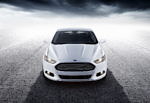

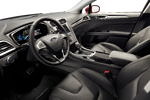








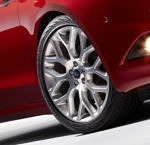

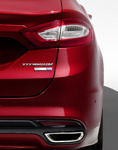








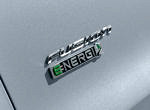







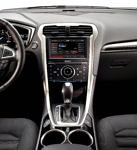
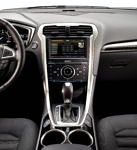
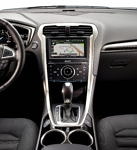
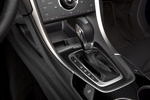
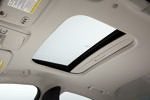
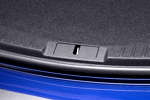
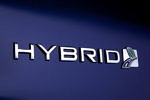
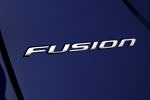
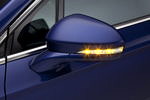
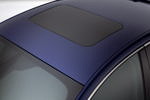
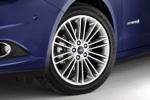
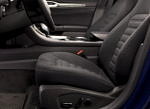

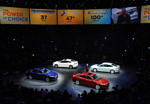
Nice artical John